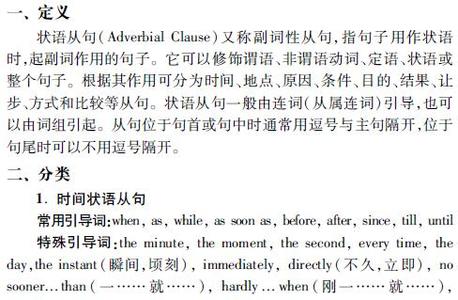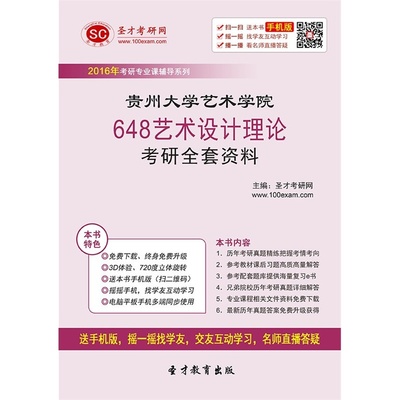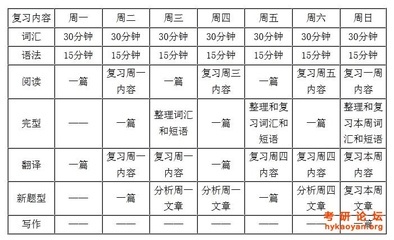1.时间状语从句
在英语中,时间状语从句的连接词常常有:when(当……的时候),whenever(每当……),as(当
……时),since(自从……),until(直到……,如果不……),til(直到……),before(在……前),after
(在……后),assoonas(一……就),once(一旦……),themoment(一……就),immediately(一……
就),theday(在……那天),nosooner...than(一……就),hardly(scarcely)...when(一……就),the
instant(一……就),instantly(一……就),directly(一……就),theminute(一……就),thesecond(一
……就),everytime(每当……),bythetime(等到……的时候)等。
1)译成与汉语完全对应的表示时间的状语
WhentheyapproachedTrenton,lightswerestilburninginmanyofthehousesandChristmasparties
werestilgoingon.
Weshaldiscusstheproblemfulybeforewemakethedecision.
Theironshouldbestrickenwhileitishot.
Ifwintercomes,canspringbefarbehind?
Whenwemeteachotherforthesecondtime,Ifoundthatshelookedolderthanshewas.
Hischilddidnotcomebackhomeuntildusksetin.
2)转译为其他状语从句:英语状语从句通常可按其从属连词、连接副词或所用的引导词的含义来
翻译,但有时它们的深层意义互相渗透,可以互相替换,需要转译。有些英语状语从句虽然形式上是
由表示时间的引导词(如 when,before,until等)引导,但根据句子逻辑意义来判断,应灵活翻译成表
因果关系的从句,或者翻译为表条件的状语从句或表目的的状语从句。
Whenwindsblowparticlesagainstalargerockforalongtime,thesofterlayersoftherockareslowly
wornaway.
Onemustsowbeforeonecanreap.
Beforemannedspacecraftcouldbesenttospace,theproblemofgetingthespacecraftsafelybackto
earthhadtobesolved.
Notuntilwehavedetailedstudiesofthepresentmovementoftraficandhaveaclearerideaofhow
manypeoplewishtotravel,wheretheywanttogo,atwhattimeofdayandhowquickly― notuntilthencan
webegintoplanapropertransportationsystemforthefuture.
3)翻译成固定句型
由 hardly(scarcely)...when(before)... nosooner...than... assoonas...themoment
(theinstant)... justas...等短语连词引导的时间状语从句翻译成汉语时,主句与从句通常要互
换,常常译成包含“刚(一)……就……”这种结构的句子。同样,包含该结构的汉语句子亦应翻译成
英语中相对应的固定句式。
Scarcelyhadwegottothestationbeforethetrainleft.
Hardlyhadthecomputerstartedworkingwhenviruseswerefound.
Assoonassheheardthenews,shefainted.
Theyfelinlovethemomenttheysaweachotherforthefirsttime.
4)译成并列分句
Theearthturnsrounditsaxisasittravelsaboutthesun.
IreadanewspaperwhileIwaswaiting/Iwaited.

IwasgoinghomewhenImetMary.
2.原因状语从句
英语中,原因状语从句的连接词常常是:because(因为),since(既然,由于),as(因为),nowthat
(既然),seeingthat(既然),consideringthat(考虑到,因为),inthat(在某方面),inviewofthefactthat
(鉴于)。
1)译成表示原因的分句
Theyareinformal,mostlikelybecausetheyarealwaysinagreathury. Becausehisparentshadpavedagoodwayforhim,hedidn’tworyaboutitatal. Itisfrequentlysaidthatcomputerssolveproblemsonlybecausetheyare“programmed”todoso. Sincethespeakercan’tcome,we’lhavetocancelthemeeting. 2)有时候可以用汉语的“之所以……是因为”的结构来连接。
Agasdifersfromsolidinthatithasnodefiniteshape. Hewilgetpromoted,forhehasdonegoodwork. Theoryisvaluablebecauseitcanprovideadirectionforpractice. 3)译为不带关联词、因果关系内含的并列分句
Asfamiliesmoveawayfromtheirstablecommunity,theirfriendsofmanyyears,andtheirextended familyrelationships,theinformalflowofinformationiscutof.
SincetheelectricalinventionswhichEdisonhadgivenuswereveryimportant,wecouldnotlivewithout them―notforoneminute.
4)not...because的结构
在翻译由 because引导的具有否定意义的原因状语从句时,尤其要注意否定意义的表达一定要确
切。not与 because发生关系,常常要翻译成“并不是因为……”。
Idon’tteachbecauseteachingiseasyforme.
Themachinedidnotmovebecausethefuelwasusedup.
3.条件状语从句
英语中连接条件状语从句的连接词常常有:if(如果),unless(除非,如果不),providingthat(假
如),solongas(只要),onconditionthat(条件是),supposethat(假如),incase(如果),onlyif(只要),if
only(但愿,要是……就好了)等。
1)译成相对应的表条件的分句
Iftheepidemiccannotbecontroledefectively,thewholecountrywilcomeintochaos. Wewon’tbeabletogothereonfootincaseitrains.
2)译成不含关联词、内含条件关系的句子
Ifthetemperaturedropstozerodegreecentigrade,waterfreezes.
Ifyouworkhard,youwilsucceed.
Ifyoumelttwoormoremetalstogether,youcangetanewmetal.
3)翻译在主句后面,用来补充说明条件。
Youcandrivetonightifyouareready.
NodoubtIcouldearnedsomethingifIhadrealymeantto.
4)译成特定的条件分句
考研英语翻译轻松突破(英语一、二)
Theymightbepreparedtotrimproduction―butonlyiftheyareconvinceditwilfirmprices. Certainlyyoucanpassthetest,butonlyifyoustudyveryhard.
4.让步状语从句
英语中,表示让步关系的连接词常常有:though(虽然),although(虽然),evenif(即使),as(尽管), while(尽管),whatever(无论什么),wherever(无论哪里),whoever(无论谁),however(无论怎样),no mater(不论,不管),foralthat(尽管),grantedthat(即使),inspiteofthatfactthat(尽管),despitethe
factthat(不管)等等。
1)译成表示 “让步”的分句
NomaterwhatIsayorhowIsayit,healwaysthinksI’mwrong. Whilewecannotseetheair,wecanfeelit. Grantedthatyoudon’tliketheproposal,youshouldn’thaverejecteditwithoutconsultingothers.
Althoughtherearetheseculturaldiferences,themainenginepropelingtheseparatistcauseiseconom
ic.
Oldasheis,hewouldratherworkthansitidle.
2)译成表 “无条件”的条件分句
英语里有一种复句,前一分句排除某一方面的一切条件,后一分句说出在任何条件下都会产生同
样的结果,也就是说结果的产生没有什么条件限制。这样的复句里的前一分句,称之为“无条件”的条
件分句,通常以 whatever,wherever,whoever,whenever,nomaterwh-为引导词,通常翻译为“不论”
“无论”“不管”等关联词。
YetwheneverIstoppedbyhishospitalbedside,hewassuroundedbyvisitorsfromhischurch,
singingandpraying.
I’lberightherewaitingforyou,whereveryougo,andwhateveryoudo. Weareal,whateverpartoftheworldwecomefrom,persuadedthatourownnationissuperiortoal
others.
5.目的状语从句
在英语中,连接目的状语从句的连接词常常有:that(为了,以便),sothat(为了,以便),lest(以
防),incase(以防,以免),forfearthat(以防)inorderthat(为了)等等。还可以翻译在主句后面,表示
“省(免)得”、“以免”、“以便”、“使得”、“生怕”等概念。
1)译成表示 “目的”的前置状语
Hepushedopenthedoorgentlyandstoleoutoftheroomforfearthatheshouldawakeher.
Weshouldstartearlysothatwemightgettherebeforenoon.
2)译成表示 “目的”的后置状语
Heisplanningtomakethisspeechinorderthatwemighthaveabeterunderstandingofthevicissitude
oftheinternationalsituation.
6.结果状语从句
1)英语中,连接结果状语从句的连词常常有:sothat,so...that,such...that,tosuchadegree等
等,通常可以翻译为“结果,如此……以致于……”,可以直接翻译。
Hemadeawrongdecision,sothathalfofhislifetimewaswasted.
Thediferenceissuchthatalwilperceiveit.
2)有时候,如果在主句中含有“never,neverso,notso,notsuch”等否定词,“butthat和 butwhat”
也可以连接结果状语从句,构成双重否定。翻译的时候,可以翻译为“没有……不”。
Shenevercomesbutsheborow. Sheisnotsooldbutthatshecanread.
7.方式状语从句
表示方式的状语从句通常由 as,asif,asthough引导,往往位于主句之后,但在 as...so...结构
中,as分句通常置于主句之前。在口语中可用 theway(that)引导方式状语从句。
Pleasedoexactlyasyourdoctorsays.
Marydoesnotbotherabouttriflesthewayhersisterdoes.
8.地点状语从句
地点状语分句是表示时空关系的分句结构。英语地点状语分句可位于主句之前,亦可置于主句
之后。汉语地点状语分句通常位于主句之前。
 爱华网
爱华网


